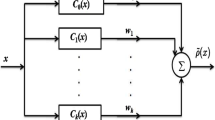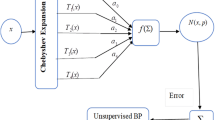Abstract
Differing from conventional improvements on backpropagation (BP) neural network, a novel neural network is proposed and investigated in this paper to overcome the BP neural-network weaknesses, which is called the multiple-input feed-forward neural network activated by Chebyshev polynomials of Class 2 (MINN-CP2). In addition, to obtain the optimal number of hidden-layer neurons and the optimal linking weights of the MINN-CP2, the paper develops an algorithm of weights and structure determination (WASD) via cross-validation. Numerical studies show the effectiveness and superior abilities (in terms of approximation and generalization) of the MINN-CP2 equipped with the algorithm of WASD via cross-validation. Moreover, an application to gray image denoising demonstrates the effective implementation and application prospect of the proposed MINN-CP2 equipped with the algorithm of WASD via cross-validation.







Similar content being viewed by others
Explore related subjects
Discover the latest articles and news from researchers in related subjects, suggested using machine learning.References
Yu S, Zhu K, Diao F (2008) A dynamic all parameters adaptive BP neural networks model and its application on oil reservoir prediction. Appl Math Comput 195:66–75
Liang L, Wu D (2005) An application of pattern recognition on scoring Chinese corporations financial conditions based on backpropagation neural network. Comput Oper Res 32:1115–1129
Zhang Y, Jiang D, Wang J (2002) A recurrent neural network for solving Sylvester equation with time-varying coefficients. IEEE Trans Neural Netw 13:1053–1063
Izeboudjen N, Bouridane A, Farah A, Bessalah H (2012) Application of design reuse to artificial neural networks: case study of the back propagation algorithm. Neural Comput Appl 21:1531–1544
Dehuri S, Cho SB (2010) A comprehensive survey on functional link neural networks and an adaptive PSO-BP learning for CFLNN. Neural Comput Appl 19:187–205
Wang W, Yu B (2009) Text categorization based on combination of modified back propagation neural network and latent semantic analysis. Neural Comput Appl 18:875–881
Zhang Y, Li W, Yi C, Chen K (2008) A weights-directly-determined simple neural network for nonlinear system identification. In: Proceedings of the IEEE international conference on fuzzy systems, pp 455–460
Zhang Y, Li L, Yang Y, Ruan G (2009) Euler neural network with its weight-direct-determination and structure-automatic-determination algorithms. In: Proceedings of the 9th international conference on hybrid intelligent systems, pp 319–324
Zhang Y, Chen J, Guo D, Yin Y, Lao W (2012) Growing-type weights and structure determination of 2-input Legendre orthogonal polynomial neuronet. In: Proceedings of the IEEE international symposium on industrial electronics, pp 852–857
Qin T, Chen Z, Zhang H, Li S, Xiang W, Li M (2004) A learning algorithm of CMAC based on RLS. Neural Process Lett 19:49–61
Qin T, Zhang H, Chen Z, Xiang W (2005) Continuous CMAC-QRLS and its systolic array. Neural Process Lett 22:1–16
Chen S, Cowan C, Grant P (1991) Orthogonal least squares learning algorithm for radial basis function networks. IEEE Trans Neural Netw 2:302–309
Chen S, Billings S, Luo W (1989) Orthogonal least squares methods and their application to non-linear system identification. Int J Control 50:1873–1896
Chen S, Wu Y, Luk B (1999) Combined genetic algorithm optimization and regularized orthogonal least squares learning for radial basis function networks. IEEE Trans Neural Netw 10:1239–1243
Montana D, Davis L (1989) Training feedforward neural networks using genetic algorithms. In: Proceedings of the international joint conferences on artificial intelligence, pp 762–767
Huang G, Zhu Q, Siew C (2006) Extreme learning machine: a new learning scheme of feedforward neural networks. Neurocomputing 70:489–501
Bebis G, Georgiopoulos M (1994) Feed-forward neural networks. IEEE Potentials 13:27–31
Boyd JP (2000) Chebyshev and Fourier spectral methods, 2nd edn. Dover Publications, New York
Liang X, Li Q (2005) Multivariable approximation. National Defense Industry Press, Beijing
Ibrahim B, Ertan I (2008) Direct and converse results for multivariate generalized Bernstein polynomials. J Comput Appl Math 219:145–155
Dunkl C, Xu Y (2001) Orthognal polynomials of several variables. Cambridge University Press, Cambridge
Zhang Y, Li K, Tan N (2009) An RBF neural network classifier with centers, variances and weights directly determined. Comput Technol Autom 28:5–9
Zhang Y, Tan N (2010) Weights direct determination of feedforward neural networks without iterative BP-training (chapter 10). In: Wang LS, Hong T (eds) Intelligent soft computation and evolving data mining: integrating advanced technologies. IGI Global, Hershey
Zhang Y, Yu X, Xiao L, Li W, Fan Z (2013) Weights and structure determination of artificial neuronets (chapter 5). In: Zhang WJ (ed) Self-organization: theories and methods. Nova Science, New York
Zhang Y, Li W (2009) Gegenbauer orthogonal basis neural network and its weights-direct-determination method. Electron Lett 45:1184–1185
Zhang G, Hu M, Patuwo B, Indro D (1999) Artificial neural networks in bankruptcy prediction general framework and cross-validation analysis. Eur J Oper Res 116:16–32
Mi X, Zou Y, Wei W, Ma K (2005) Testing the generalization of artificial neural networks with cross-validation and independent-validation in modelling rice tillering dynamics. Ecol Model 181:493–508
Engel J (1996) Choosing an appropriate sample interval for instantaneous sampling. Behav Process 38:11–17
Pawlus P, Zelasko W (2012) The importance of sampling interval for rough contact mechanics. Wear 276–277:121–129
Ji Z, Chen Q, Sun Q, Xia D (2009) A moment-based nonlocal-means algorithm for image denoising. Inf Process Lett 109:1238–1244
Nguyen-Thien T, Tran-Cong T (1999) Approximation of functions and their derivatives a neural network implementation with applications. Appl Math Model 23:687–704
Huang G, Saratchandran P, Sundararajan N (2005) A generalized growing and pruning RBF (GGAP-RBF) neural network for function approximation. IEEE Trans Neural Netw 16(1):57–67
Gonzalez R, Woods R (2003) Digital image processing, 2nd edn. Publishing House of Electronics Industry, Beijing
Ibnkahla M (2007) Neural network modeling and identification of nonlinear MIMO channels. In: Proceedings of the 9th international symposium on signal processing and its applications, pp 1–4
Zhang T, Zhou C, Zhu Q (2009) Adaptive variable structure control of MIMO nonlinear systems with time-varying delays and unknown dead-zones. Int J Autom Comput 6:124–136
Acknowledgments
The authors would like to thank the editors and anonymous reviewers sincerely for their time and effort spent in handling the paper, as well as many constructive comments provided for improving much further the presentation and quality of the paper. This work is supported by the Specialized Research Fund for the Doctoral Program of Institutions of Higher Education of China (with Project Number 20100171110045), the National Innovation Training Program for University Students (with Project Number 201210558042), and the 2012 Scholarship Award for Excellent Doctoral Student Granted by Ministry of Education of China (under Project Number 3191004).
Author information
Authors and Affiliations
Corresponding author
Rights and permissions
About this article
Cite this article
Zhang, Y., Yu, X., Guo, D. et al. Weights and structure determination of multiple-input feed-forward neural network activated by Chebyshev polynomials of Class 2 via cross-validation. Neural Comput & Applic 25, 1761–1770 (2014). https://doi.org/10.1007/s00521-014-1667-0
Received:
Accepted:
Published:
Issue Date:
DOI: https://doi.org/10.1007/s00521-014-1667-0




